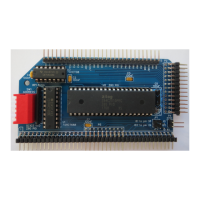A
B
D
H
F
C
E
L
Fig. 2
-
2. Register block combinations.
A
B
D
H
F
C.
E'
L'
A
B
D
H
F'
C
E
L
W
H
NON PRIME
NON PRIME
NON PRIME
PRIME
PRIME
NON PRIME
PRIME
PRIME
The result of the operation always goes into the A register. In gen-
eral, then, the currently selected A register is the main register for
performing arithmetic and logical operations as shown in Fig. 2-3.
The remaining six registers are grouped into
register pairs
B,C;
D,E; and H,L. For many operations in the 8008, 8080, and Z-80 the
data within the three register pairs represents a memory address.
The H,L registers, for example, originally specified a High memory
address of eight more significant bits and a Low memory address of
eight less significant bits as shown in Fig. 2-4. The same is true of
the B,C and D,E registers. In the 8080, the capability also was pro-
vided to allow the B,C and D,E to specify a memory address, giving
three register pairs that could hold a memory address
pointer
to
data in memory. In general, the three register pairs will hold mem-
ory addresses as shown in Fig. 2-4, although a second use for them
is to allow
double-precision arithmetic.
8-BIT
AR ITHMETIC OR
LOGICAL RESULT
AL
U
A
FL
GS
OPERA
ND 1
OPER
AND 2
MEMORY OPERAND
AIOR A9
B (OR 8
1
C (C')
1
OTHER GEN-
L
L (n
E (E'1
ERAL PURPOSE
H (H ')
_A
L (L')
J
REGISTERS
Fig. 2-3. Arithmetic
and logical operations.
17

